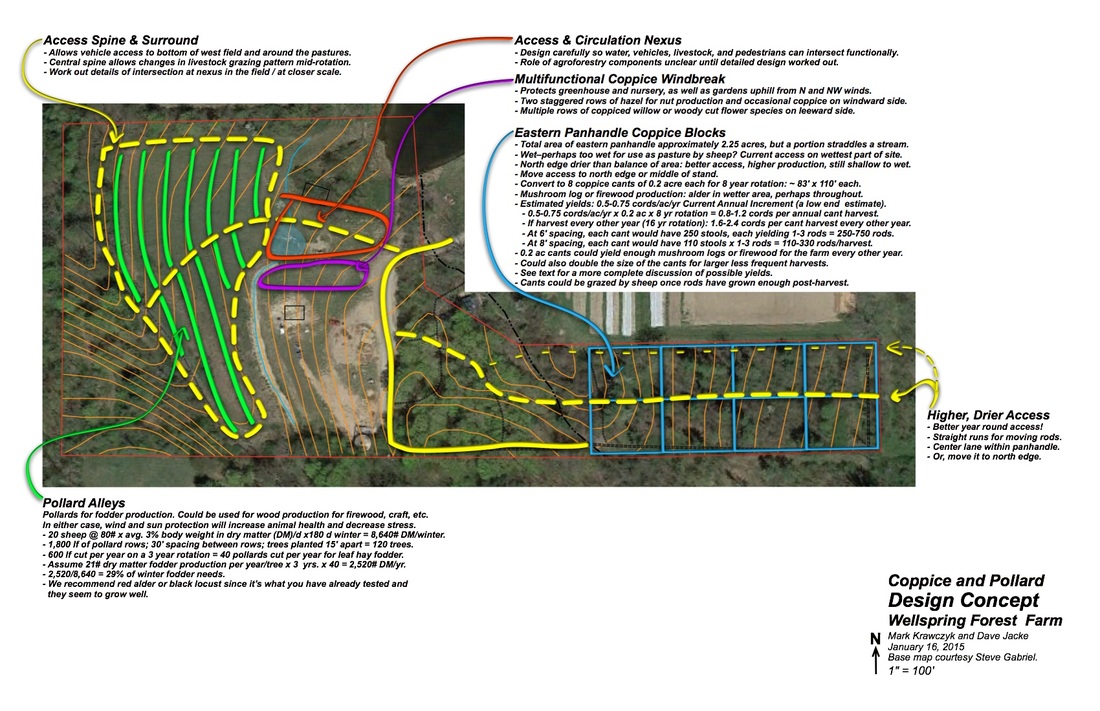Case Studies: Co-created by Mark Krawczyk and Dave Jacke
In late winter of 2014, we received notice that we had been awarded a grant from the US Department of Agriculture SARE (Sustainable Agriculture Research and Education) Partnership grant program to support work on our book. Part of the grant involved us doing case studies or "sketch problems" on how one might apply coppice agroforestry concepts to three farms here in the Northeastern U.S. You can read more about the grant project overall and some of the things we learned from it in the final report published on the USDA website. Nonetheless, we thought we should put the case studies themselves up here so y'all can partake.
We worked with three farms for this part of the project:
The case study for each is available below for your downloading and reading pleasure. Enjoy!
PLEASE NOTE: These sketch problems are just that: sketches. They do not represent finished or finalized farm designs! Much work and thought needs to be put in to create workable final farm system designs for these projects beyond what we could do in this grant. Our intentions in this project were to explore new territory and get a sense of whether and how coppice systems might integrate into these farms. For example, in response to the Wellspring Farm study, Darren Doherty, a world leader in keyline systems, critiqued the pattern of the pollard alleys in terms of layout relative to the contours for keyline purposes, and rightly so! That design also does not address needs and concerns about how and where to store the pollard material once harvested. Both of these are major issues we did not have time or space to address in that study in particular. Similar issues will be found in the other sketch problems as well. But, crossing every 't' and dotting every 'i' was not our intention here. So take what you like, leave the rest, learn from what these studies have to offer, and keep your eyes and hearts on the lookout for missing pieces, errors, and so on in these pieces of work. They are most certainly flawed! We appreciate your understanding and shared learning in this field.
This material is based upon work supported by Sustainable Agriculture Research and Education in the National Institute of Food and Agriculture, U.S. Department of Agriculture, under award number 2013-38640-20895. Any opinions, findings, or recommendations expressed in this publication are those of the authors and do not necessarily reflect the view of the U.S. Department of Agriculture.
Dave and Mark
We worked with three farms for this part of the project:
- Wellspring Forest Farm in Mecklenburg, NY, home of Elizabeth and Steve Gabriel and featured in Steve's book Farming the Woods, written with Ken Mudge. Steve and Elizabeth grow sheep, mushrooms, ducks, and maple sap.
- Sovereign Hill Farm, a sheep and goat farm run by Kathrin Woodlyn Bateman in Chester, MA.
- An anonymous farm we call "No Name Farm" proposed to regenerate an auto salvage yard in an urbanized region of the Northeast (please respect these folks' desire for anonymity!).
The case study for each is available below for your downloading and reading pleasure. Enjoy!
PLEASE NOTE: These sketch problems are just that: sketches. They do not represent finished or finalized farm designs! Much work and thought needs to be put in to create workable final farm system designs for these projects beyond what we could do in this grant. Our intentions in this project were to explore new territory and get a sense of whether and how coppice systems might integrate into these farms. For example, in response to the Wellspring Farm study, Darren Doherty, a world leader in keyline systems, critiqued the pattern of the pollard alleys in terms of layout relative to the contours for keyline purposes, and rightly so! That design also does not address needs and concerns about how and where to store the pollard material once harvested. Both of these are major issues we did not have time or space to address in that study in particular. Similar issues will be found in the other sketch problems as well. But, crossing every 't' and dotting every 'i' was not our intention here. So take what you like, leave the rest, learn from what these studies have to offer, and keep your eyes and hearts on the lookout for missing pieces, errors, and so on in these pieces of work. They are most certainly flawed! We appreciate your understanding and shared learning in this field.
This material is based upon work supported by Sustainable Agriculture Research and Education in the National Institute of Food and Agriculture, U.S. Department of Agriculture, under award number 2013-38640-20895. Any opinions, findings, or recommendations expressed in this publication are those of the authors and do not necessarily reflect the view of the U.S. Department of Agriculture.
Dave and Mark
| wellspringforestfarmcoppicecasestudy_150413.pdf | |
| File Size: | 8693 kb |
| File Type: | |
| sovereignhillfarmcoppicecase_study_150413.pdf | |
| File Size: | 7762 kb |
| File Type: | |
| nonamefarmcoppicecase_study_150413.pdf | |
| File Size: | 4583 kb |
| File Type: | |
